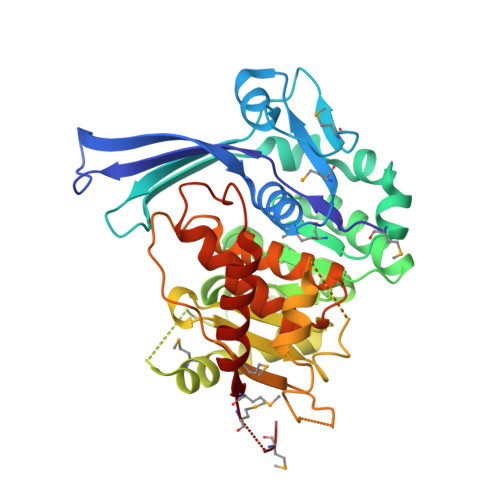Structural basis for the substrate specificity and catalytic features of pseudouridine kinase from Arabidopsis thaliana.
Kim, S.H., Witte, C.P., Rhee, S.(2021) Nucleic Acids Res 49: 491-503
- PubMed: 33290549
- DOI: https://doi.org/10.1093/nar/gkaa1144
- Primary Citation of Related Structures:
7C1X, 7C1Y, 7C1Z - PubMed Abstract:
RNA modifications can regulate the stability of RNAs, mRNA-protein interactions, and translation efficiency. Pseudouridine is a prevalent RNA modification, and its metabolic fate after RNA turnover was recently characterized in eukaryotes, in the plant Arabidopsis thaliana. Here, we present structural and biochemical analyses of PSEUDOURIDINE KINASE from Arabidopsis (AtPUKI), the enzyme catalyzing the first step in pseudouridine degradation. AtPUKI, a member of the PfkB family of carbohydrate kinases, is a homodimeric α/β protein with a protruding small β-strand domain, which serves simultaneously as dimerization interface and dynamic substrate specificity determinant. AtPUKI has a unique nucleoside binding site specifying the binding of pseudourine, in particular at the nucleobase, by multiple hydrophilic interactions, of which one is mediated by a loop from the small β-strand domain of the adjacent monomer. Conformational transition of the dimerized small β-strand domains containing active site residues is required for substrate specificity. These dynamic features explain the higher catalytic efficiency for pseudouridine over uridine. Both substrates bind well (similar Km), but only pseudouridine is turned over efficiently. Our studies provide an example for structural and functional divergence in the PfkB family and highlight how AtPUKI avoids futile uridine phosphorylation which in vivo would disturb pyrimidine homeostasis.
Organizational Affiliation:
Department of Agricultural Biotechnology, Seoul National University, Seoul, Korea.
















